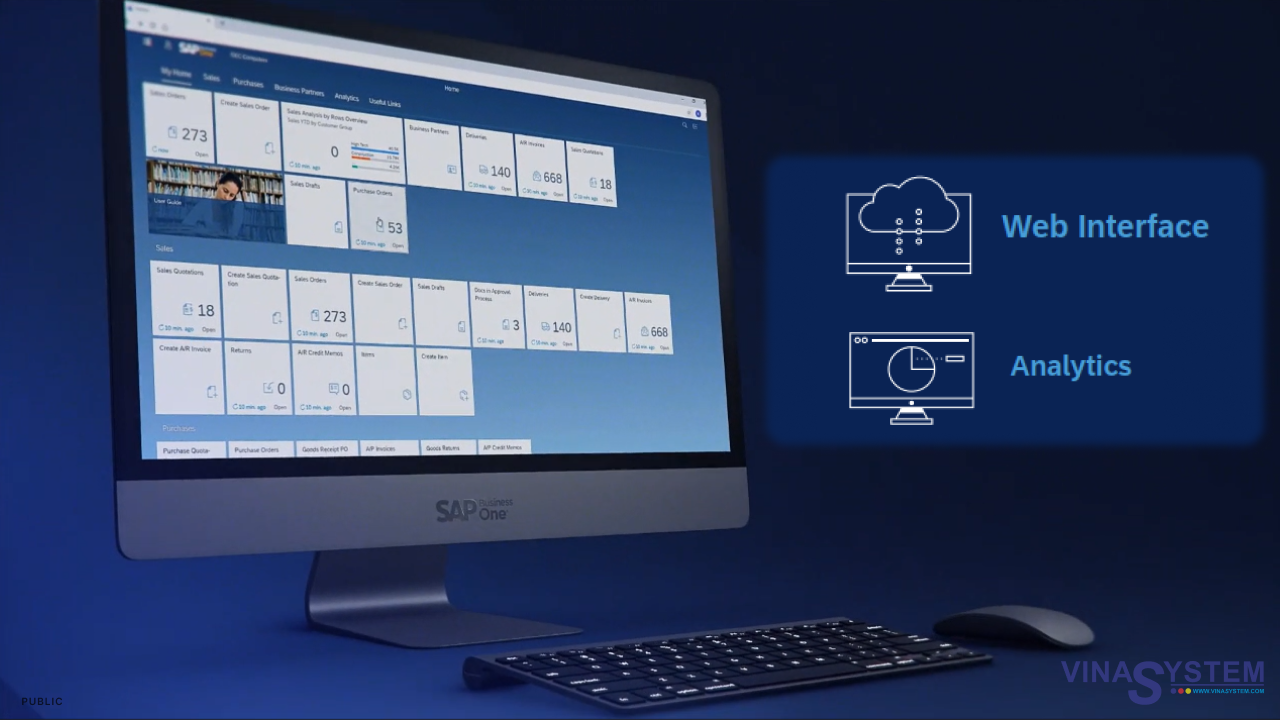
Tài liệu thiết lập các nhóm giảm giá dành cho khách hàng trong SAP Business One
Welcome to the pricing topic on discount groups in SAP Business One. In this topic, you will learn how to set up discount groups to meet your pricing needs.
I/ Business Scenario
Imagine that your company wants to introduce some new discounts.
Some of these offers will be based on specific customer groups, other offers will be available to all business partners but based on specific items or manufacturers.
Some customers will be eligible for multiple discounts on the same product, but others will receive only one of the discounts.
One offer will be a “pay for 2 – get one free” deal for a range of products such as mobile phones, ink cartridge refills and DVD discs.
To create these discount offers, you can use discount groups.
II/ Discount Basis

Discount groups are the most flexible type of pricing.
You can assign a discount group to a specific business partner, a business partner group or even to all business partners.
The discounts are defined for specific items or item groups, a combination of item properties or an item manufacturer.
Multiple discounts can be defined within the discount group. For example, within the same discount group you can have a discount on an item group as well as a discount for a specific manufacturer.
Discounts can be set at a percentage or be calculated by quantity purchased.
Let us go through the different combinations of discounts you can create using discount groups.
1/ Creating discount groups

The first step in creating a discount group is to think of the kinds of discounts that would be appropriate to one or more business partners and group them together inside the discount group.
For example you may wish to give retail customers 5% off printers and an offer of 1 free case of recycled paper when they buy 2 cases. A different set of discounts may apply to the customer group for large customers. For them, you might offer 2% off products from the manufacturer Rainbow and 3% off any items that have the item property of business products.
Once you know the type of discounts you wish to group together, the first step in creating the discount group is to choose the business partners that the discounts will apply to.
2/ Assigning Discount Groups

Discount can be assigned not only to specific business partners, but to business partner groups (such as vendor or customer groups) or even be assigned to all business partners.
Because you can assign a discount for groups and for all business partners, SAP has provided the option to exclude specific business partners from discount groups. We will come back to that later on in this topic.
Now we will take a look at the specific types of discounts available in every discount group and how they are applied.
3/ Discount Groups for Item Groups

Four tabs are available in every discount group for defining discounts: Item Groups, Properties, Manufacturers and Items.
First we will look at item groups.
The item group tab displays all the item groups defined for the company.
You enter the discount you desire on the row for each item group.
The default form settings show only the option for percentage discounts, however, you can add the fields for giving free items based on quantity purchased in the Form Settings window.
Once you have set a discount based on an item group, all items belonging to that item group are automatically included in the discount.
This means that when a new item master is assigned to an item group, it will automatically be added to any discount group that is based on that item group.
4/ Discount Groups for Properties

Another option is to use item properties as way to indicate items that should be discounted.
A nice feature of discount groups at the item properties level is that SAP Business One allows you to define a discount for several properties at once.
Additionally, you can use a rule to decide which discount is used by the system for the calculation:
- The highest discount -The property with the highest discount will determine the overall discount calculated for the item.
- The lowest discount -The property with the lowest discount will determine the overall discount calculated for the item.
- The average discount -The system calculates the average of all the discounts for the properties. The average is used as the discount.
- Discount totals - The system adds together all discounts of the properties that apply to the item. The total (up to 100%) is used as the discount.
- Discount multiples – The system multiplies the discounts of the properties that apply to the item.
5/ Discount Groups for Manufacturers

Another way to define a discount group is by manufacturer.
For example, imagine that you sell Rainbow-brand printers and accessories. The manufacturer, Rainbow, offers you a lower price as a distributor for all their products. You would like to pass on some of these savings by discounting all Rainbow products by 2% for large customers.
You can set up a discount group for the large accounts customer group which includes a 2% discount for all products manufactured by Rainbow.
6/ Discount Groups for Items

The fourth tab is the Items tab.
Here you can list individual items that you want to discount. Unlike the other tabs, the list is empty until you add the items you wish to discount. This makes sense if you think about the large number of items that a company can have.
Here we see a discount group set up for schools to promote copy paper sales.
III/ Free Goods

Companies often need to offer incentive pricing with free goods. Discounts can be based according to the quantity purchased.
Free goods discounts can be set on all four tabs.
There are 3 fields for setting a variable discount according to the quantity purchased.
The fields are hidden until you select them in Form Settings and then widen the window or scroll to view the additional fields.

To set up a variable discount according to the quantity purchased:
- You specify the paid quantity in the first column. This is the quantity that a customer will pay or that you would purchase from a vendor. In this example the paid quantity is 2.
- The second column specifies the quantity that is given for free when the paid quantity is purchased. In this example, the customer receives 1 free item for every two purchased.
- The last field is optional, but specifies a limit for the free items. In the example this is set to 4. A customer will receive up to 4 free items if 8 are purchased. If more than 8 are purchased, the customer still receives only 4.
Note that purchased items and the free items must have the same item code. The functionality does not cover the purchase of items with a different item as the free item.
1/ Free Goods Discount Calculation

Let us explore how the discount is actually calculated.
In the example shown, the discount group is set up as follows:
- The paid quantity is set to 2
- The free quantity is set to 1
- The maximum number of free items is 4.
If the customer purchases a quantity of 2, no discount is applied.
If the customer purchases a quantity of 3, the discount is applied giving 33.33% off of the regular price. In other words, the customer buys 3 but gets 1 of the 3 for free.
If the customer purchases 4 items, they only get the discount based on a quantity of 3 purchased, therefore the discount percentage is reduced from a third to a quarter.
If the customer purchases a quantity of 6 items, the discount is 33.33%. The customer pays for 4 items and gets 2 items for free.
The customer essentially gets 1 free item with every 3 items purchased, up to the maximum limit of 4 free items.
So, if the if the customer purchases 12 items (4 * 3 items), they will get the maximum number of free goods.
2/ Free Goods in the Sales Order

We can see the effect of the multiple quantity discount in a sales order.
When the item quantity is entered in the row, the system automatically enters the calculated discount percentage in the row.
When the item quantity entered is 3, the system automatically enters a discount of 33.33% in the Discount field in the sales order row.
If the customer later returns one of the items, the customer will receive a refund based on the discounted purchase price.
In this example, the customer would receive one third of the total price paid for the three items.
3/ Free Goods or Percentage

For any given row, you define the discount either by a fixed discount percentage or a variable discount according to the purchased quantity.
In other words, the two types of discount are mutually exclusive.
In the example, we see the free goods columns are grayed out for the first row where the fixed discount percentage is defined.
In the next two rows, the discount percentage column is grayed out because we have defined discount according to purchased quantity for these items.
IV/ Price Determination

When the system searches for a price, it looks for the most specific type of price first.
First the system looks for special prices for business partners.
If none exist, then the system searches for discount groups.
The system will look for discount groups that apply this business partner, the business partner groups associated with that business partner or a discount group that applies to all business partners.
Once discount groups are found, the system not search for other pricing types.
There are some factors controlling whether a discount group will be found when a marketing document is created.
1/ Validity settings

One of the factors controlling whether a discount group is applied in a document is the validity settings.
Like all prices, you have the option to mark a discount group as inactive or set a range of validity dates for a discount group.
You can mark the discount group as active or inactive. Discount groups are active by default.
If a date range is set for an active discount group, the discount will apply to a marketing document if the document posting date falls in the active date range.
2/ Excluding BPs or Items

Another factor for applying a discount group in a marketing document may be that an a business partner or item is excluded from discount groups.
Even though you set up a discount group to apply to all business partners you have the option to exclude a business partner from all discount groups.
Perhaps this customer has some very specific contractual agreements or you perhaps choose not to apply any discount groups for new customers until they have purchased a certain amount.
Similarly you have the option to exclude an item from all discount groups even if that item would normally be included in a discount based on item group, item properties or manufacturer. Perhaps it is a seasonal item that you never discount during peak season sales.
In any of those cases you can choose to exclude the business partner or item in the master data record.
3/ Excluding BPs

The checkbox is located on the Payment Terms tab of the business partner master data. The checkbox is unchecked by default.
If you select the Do Not Apply Discount Groups checkbox, any discount group that would apply normally will be ignored in marketing documents for this business partner.
This checkbox affects only discount groups and not other special prices.
Even if the checkbox is marked for a business partner, you can still set a discount manually in the header area or the row of a document.
This setting does not affect discounts copied from base documents. When copying a document to a target document, the discounts from the base document are still copied to the target document regardless of what is defined in the Do Not Apply Discount Groups checkbox.
For example, there could be a sales order created before the checkbox was marked for a business partner.
4/ Exclude Item from Discount Groups

The same checkbox appears in the item master data to exclude a specific item from discount groups. This might be useful for a seasonal item which you do not want to discount during the prime season.
As with the business partner setting, you can still manually apply discounts for the item in marketing documents.
Discounts from a base document are copied to the target document even if the Do Not Apply Discount Groups checkbox is set.
IV/ Multiple Discounts

After the system has eliminated a special price for the business partner and item in a sales document row, the system looks for a discount group.
However, since discount groups can apply to a specific business partner, a business partner group and to all business partners with overlapping validity periods, the system may find more than one discount group.
In fact, even within a discount group, multiple discounts could apply, for example if a discount group contains a 3% on an item group that contains items that are also eligible for a 5% discount by manufacturer.
In all those cases, the system must determine how to apply the multiple discounts found.
The way to handle the issue of multiple discounts is to set a rule for determining the effective discount.
V/ Effective Discount Rule

You can set the rule for effective discount for a business partner or for a business partner group You can select one of five settings for the effective discount – Lowest, Highest, Average, Total or Multiplied:
Lowest Discount - The lowest available discount is taken (This is the default).
Highest Discount - The highest available discount is taken.
Average - The average of all available discounts is taken.
Total - The sum of all available discounts is taken
Multiplied - The system multiplies all available discounts and uses the result as the discount.
When you create a new business partner record, the system will ask if you want to bring in the effective discount from the business partner group. If you say “no”, the new business partner will default to the lowest effective discount. You can change this at any time in the business partner master data.
Note: effective discount is obviously disabled if you have checked the Do Not Apply Discount Groups checkbox.
You can also change the effective discount in the business partner groups setup windows. If you select a new effective discount value, you will be asked whether to update all existing business partner records for the group.
VI/ Advantages of Discount Groups

A big advantage in using discount groups is when you create new items, they are automatically included any discount groups that apply.
For example, let us say you have a discount group for products assigned to the item group for scanners. Anytime you create a new item and assign it to the item group for scanners, it will automatically belong to the discount group for scanners.
You can include or exclude items and business partners
You can set up free pricing for goods based on quantities purchased as well as fixed percentage discounts.
Additionally, reporting is available for discount groups.
VII/ Summary
Here are some key points:
- Here are some key points that show the advantages and flexibility of discount groups.
- Discount Groups can be set up for specific BPs, BP groups or all BPs.
- Within a discount group you can set discounts on item groups, properties, manufacturers or items.
- If multiple discounts for properties are set in a discount group, a rule is used to determine how to apply the discounts.
- Discounts can be based on a fixed percentage or on a variable quantity purchased. The latter is used for giving free goods.
- New items are automatically added to any applicable discount groups based on item groups, properties or manufacturers.
- Items and business partners can be excluded from discount groups.
- Discount groups can have validity periods or be marked as inactive.
- Effective discount rules resolve situations where multiple discount groups apply in a marketing document.






